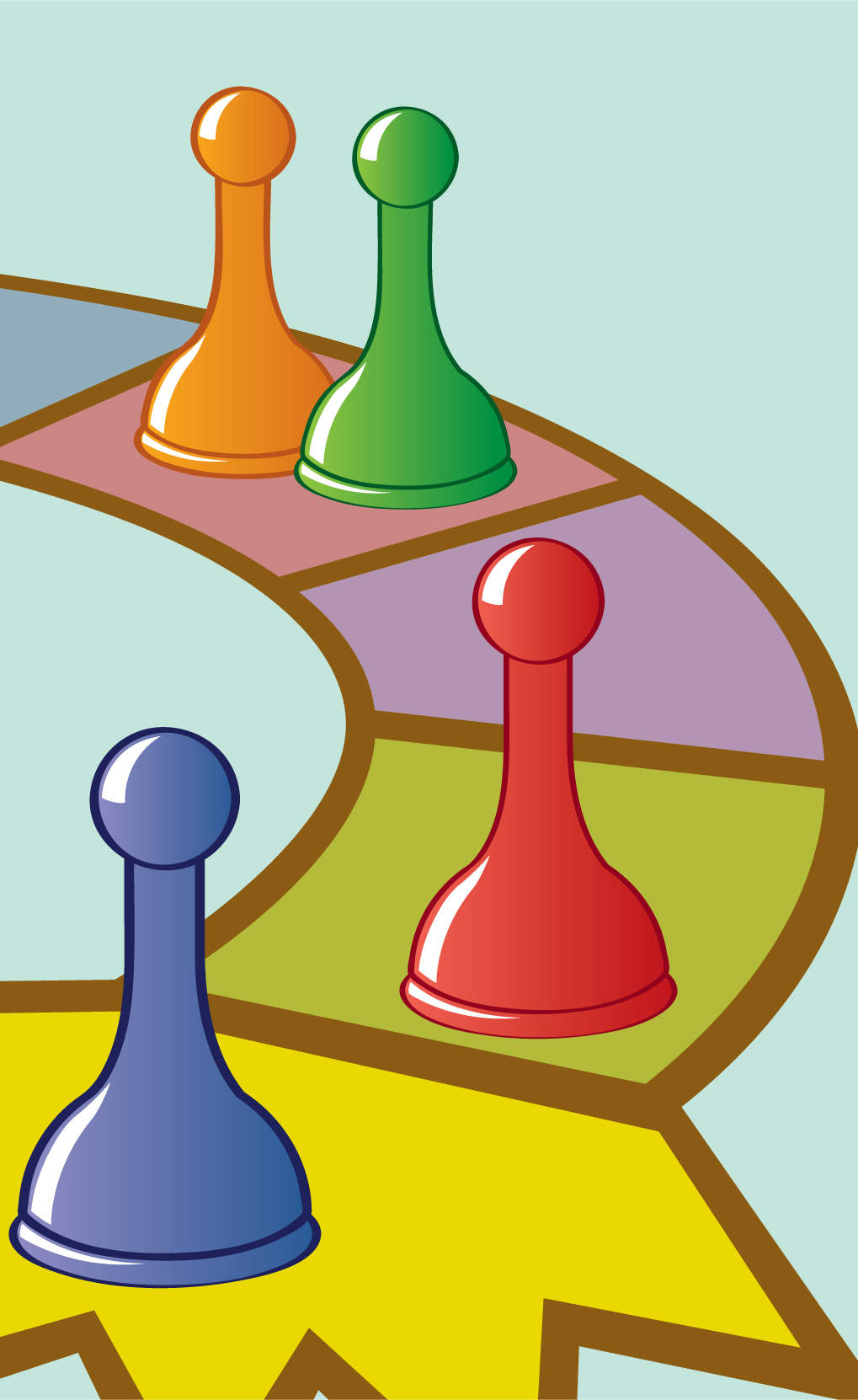Spicing Up Your Classroom With Games
Spicing Up Your Classroom With Games
By Melanie Pearlman
Games allow teachers to interact with their students in a different way than they normally do. They also have the potential to challenge and assess students’ understanding of content. Games allow me to “play” with my students in ways that other learning activities do not (Kirkland and O’Riordan 2010). I can be silly, competitive, cooperative, lenient, creative, and supportive alongside my students in a way that I cannot during lab activities, assessments, or even project work time.
When was the last time you sat in a classroom as a student instead of as the teacher? Did you notice what types of activities you enjoyed and which frustrated or bored you? I have found profound professional development as a student—and the subject doesn’t really matter: art, aerobics, religion, educational pedagogy. Being on the receiving end of a lesson helps me rethink what I plan for my students.
Daylong classes or workshops really make me think, “Is this what it’s like for my students to go to six classes every day?” Even if the classes are interesting and engaging, a full day of the same format is tiring and bland. I know I prefer some spice in a day like that, and playing educational games is one way to add variety.
Spices, of course, do not make a meal, but they make a meal more enjoyable and memorable. Games do the same, allowing teachers to interact with their students in a different way than they normally do. They also have the potential to challenge and assess students’ understanding of content. Games allow me to “play” with my students in ways that other learning activities do not (Kirkland and O’Riordan 2010). I can be silly, competitive, cooperative, lenient, creative, and supportive alongside my students in a way that I cannot during lab activities, assessments, or even project work time.
This is an investment in classroom morale. The objective for a class period of games may not necessarily be content-specific. But I argue that it’s just as vital to establish a rapport with your class in order for them to be comfortable asking questions, trying new things, and sharing ideas. While classroom atmosphere and student engagement are enough to warrant some game time in the science classroom, there is also much opportunity for learning in the context of play (Table 1, p. 42).
I know from raising my own kids that they learned much early arithmetic by playing Monopoly and with Pokémon cards. Hangman became an opportunity to learn spelling. There were teachable moments arising from games that kids think are inherently fun. What games do you know and enjoy that can be used to practice skills or grasp concepts in a classroom? I put classroom games into three categories: 1)active games that spice up review of content already covered 2)simulations that personalize content 3)adaptation of commercially produced games to increase depth of content knowledge
I don’t take credit for making up any of these games. I’ve referenced their origins, but in many cases, these are adaptations of games I’ve seen at conferences, presented online, or even being played at a party. The examples that follow have been used in physical science and physics class but could be adapted for use in many different subjects.
Review games
I got this idea from a now-defunct magazine called Family Fun, and have used it in the classroom for many years. It was originally published with the title “The Homework Game” and it was for use at home, to review for a test. I call it “Oops,” because that word is on the consequence cards and game board. It can be used for any subject, the preparation is easy, and it is played in small groups, allowing each student to have plenty of time to answer questions.
Students play in groups of two or three as they travel around a game board, asking each other questions from a chapter or recently finished unit. Points are earned for correct answers. There are spaces marked “Oops!” that require the draw of a consequence card (lose points, go backwards on the game board, etc.). Points, consequences, and progress around the board are really just to keep them engaged in reviewing (Figures 1 and 2).
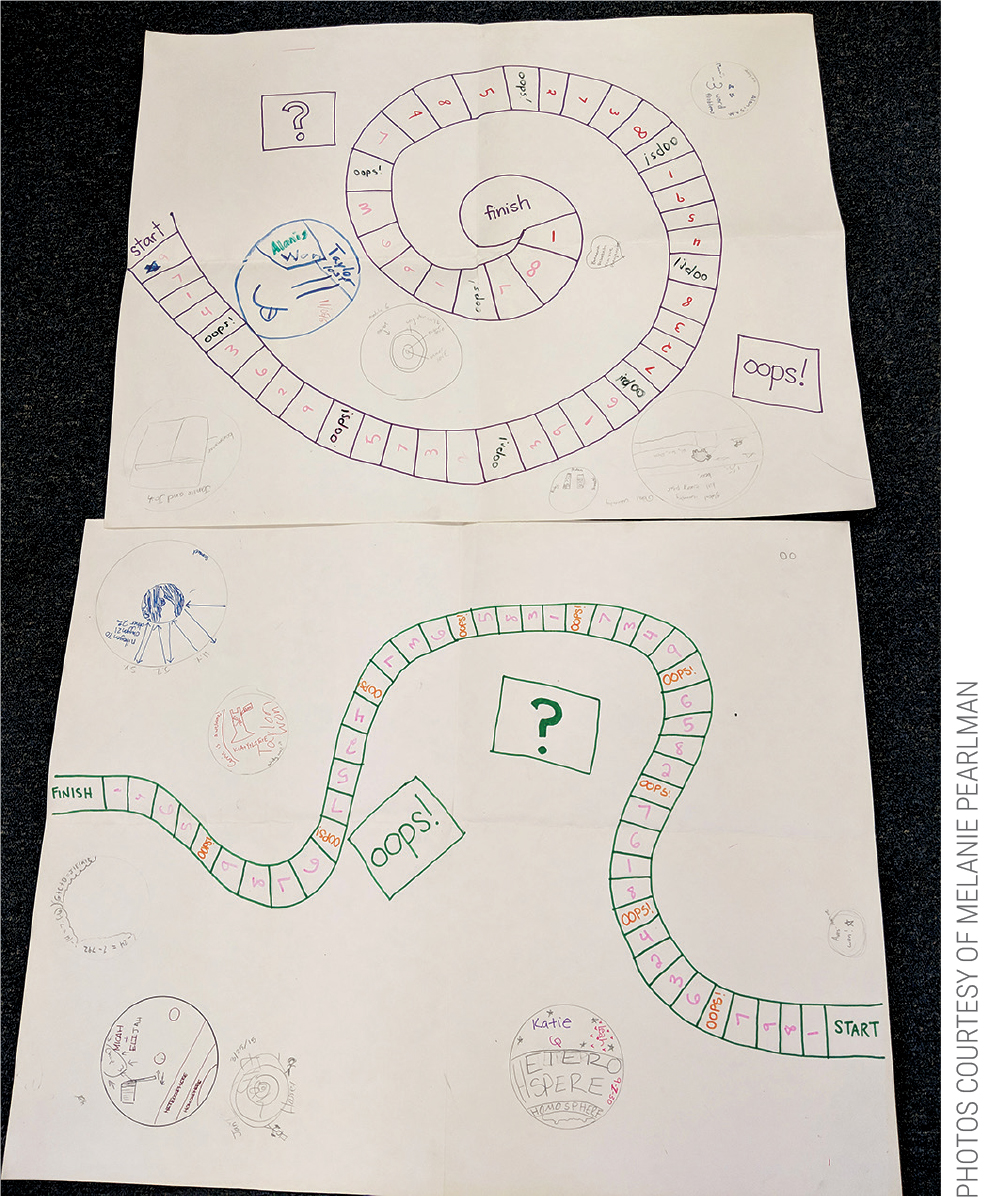
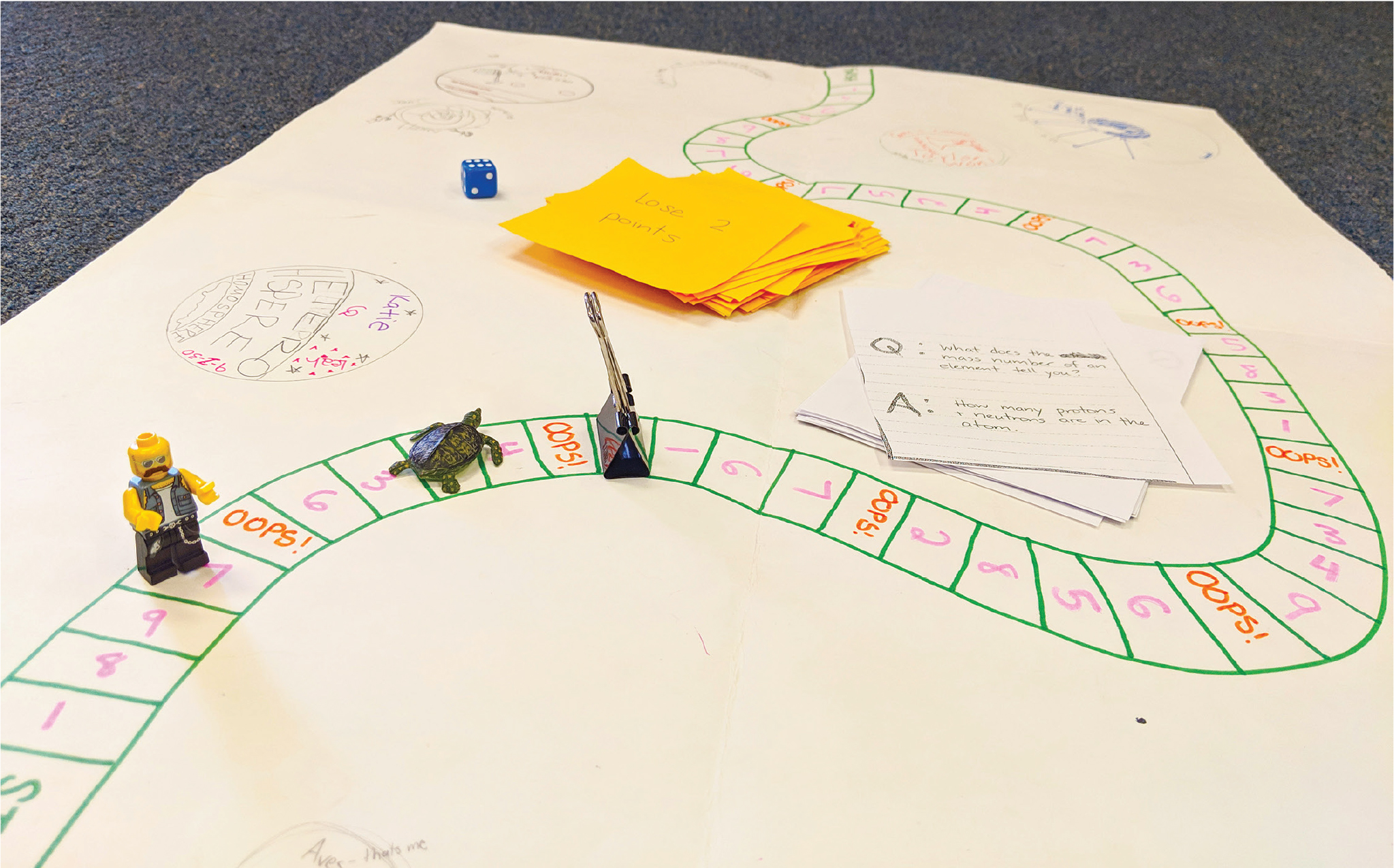
Students choose a small object of their own to use as a game piece, or choose from a box of teacher-provided examples from which they may borrow. Once you have the game boards and Oops! cards made, all you need to do to prepare is copy a set of cards for each group with a question and its answer on each one. Sixteen to 20 of these cards is enough for groups of three to play for 20 minutes or so.
If I have the opportunity to plan ahead, I have students write the questions themselves the day before. They review before they review! They each write 10 questions and answers from which I pick the 20 best-worded questions, making sure they cover everything I want them to study.
Simulations
I usually think of social studies classes where simulations are concerned (battle reenactments, stock market simulations, etc.). Simulations in science class are often on a computer: modeling change over time or changing parameters of a planet system and watching how the force of gravity is affected. These are helpful models, especially when the subject is too big, too complex, or too dangerous to have inside a classroom (like planets and their satellites).
As a fun to way to visualize something pretty abstract, I like to play “nuclear fission chain reaction tag.” It is similar to playground tag games; students start off in groups of four or so, with their elbows hooked together. Then one student, who is “it” (representing a neutron), walks to tag one of the groups. (Students are cautioned to walk quickly but to not run, for safety reasons.) Once a group is tagged, then all the members of that group unhook their arms, break apart, and are now “it” (free neutrons) and try to tag the others. The point is that students see how quickly the game is over.
Varying the size of the initial groups shows that bigger groups (representing bigger nuclei) produce a lot of new “its” very quickly (representing neutrons and daughter products), illustrating why isotopes near the bottom of the periodic table are used as fuel for nuclear fission reactions, for example. Students become a part of a living scientific model, which increases the impact, and it drives the lesson home for them.
Adaptations of existing games
I had a history teacher in high school who loved to play Jeopardy. Every chapter would end with this game, and I’ve seen many teachers use it. When we played, the class was divided into two teams, so each student only had to answer maybe once during the whole game. Now that I am a teacher, I look back and think how the game could have been more effective. We don’t need to reinvent the wheel, however, and many games that children already enjoy have potential for teaching your content.
Taboo (made by Parker Brothers in 1989, now by Hasbro) is a party game that builds vocabulary understanding and communication. Players see a card with a word on it that you must describe, in order to get the others on your team to guess. Also on the card is a list of four or five other words you are not allowed to say in your description. I like using this for vocabulary-rich sections or chapters. For example, I employ Taboo near the end of a chapter on the hydrosphere. One of the words to guess is firn (granular snow, especially on the upper part of a glacier) and the disallowed words are ice, snow, packed, and pile. I choose the taboo words from our book’s definition or how we’ve most often described the term’s meaning. This way, students need to construct the meaning from their own vernacular, and be able to understand it when described by others.
Water Works (made by Parker Brothers in 1972) is a card game where the object is to complete a spigot-to-spout pipe without leaks or breaks. I show my students this game during our unit on electricity. The analogy of pumping water through a pipe is often used for an electric circuit, so I ask them to design a similar game, but about electric circuits. This activity requires that students analyze and apply what they know about electric circuits, and what the similarities and differences are with a water pipe system. They make analogies and also show where the analogies break down.
The group processing and peer editing that goes on during the formation of these modified games is worth the time invested for the activity. I use this as a formative assessment, to see if students understand the nature of electric current and can explain to me why current flows in a circular path. After the games are designed, students make their own physical game cards and play the game together (Figures 3 and 4).
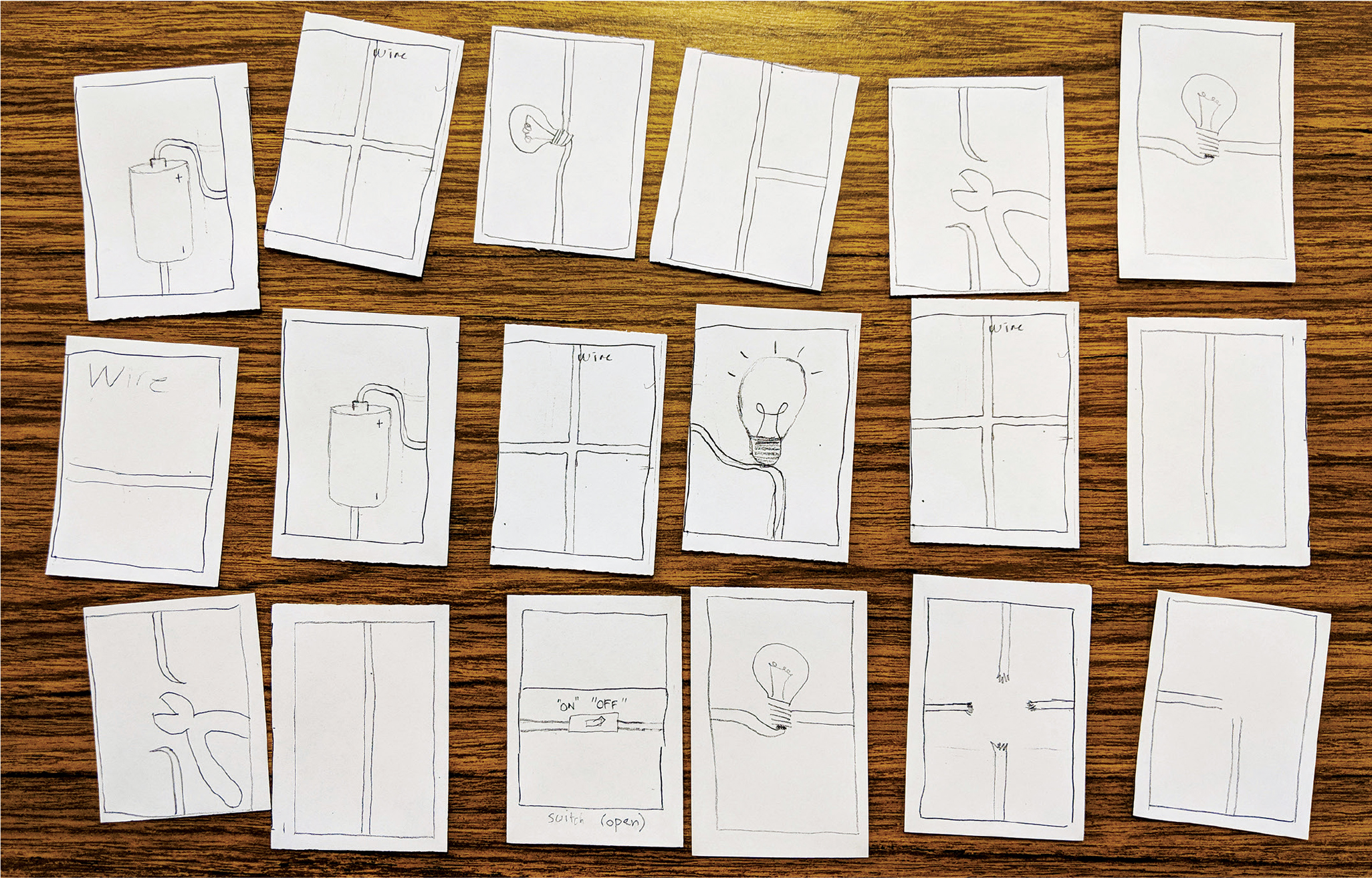
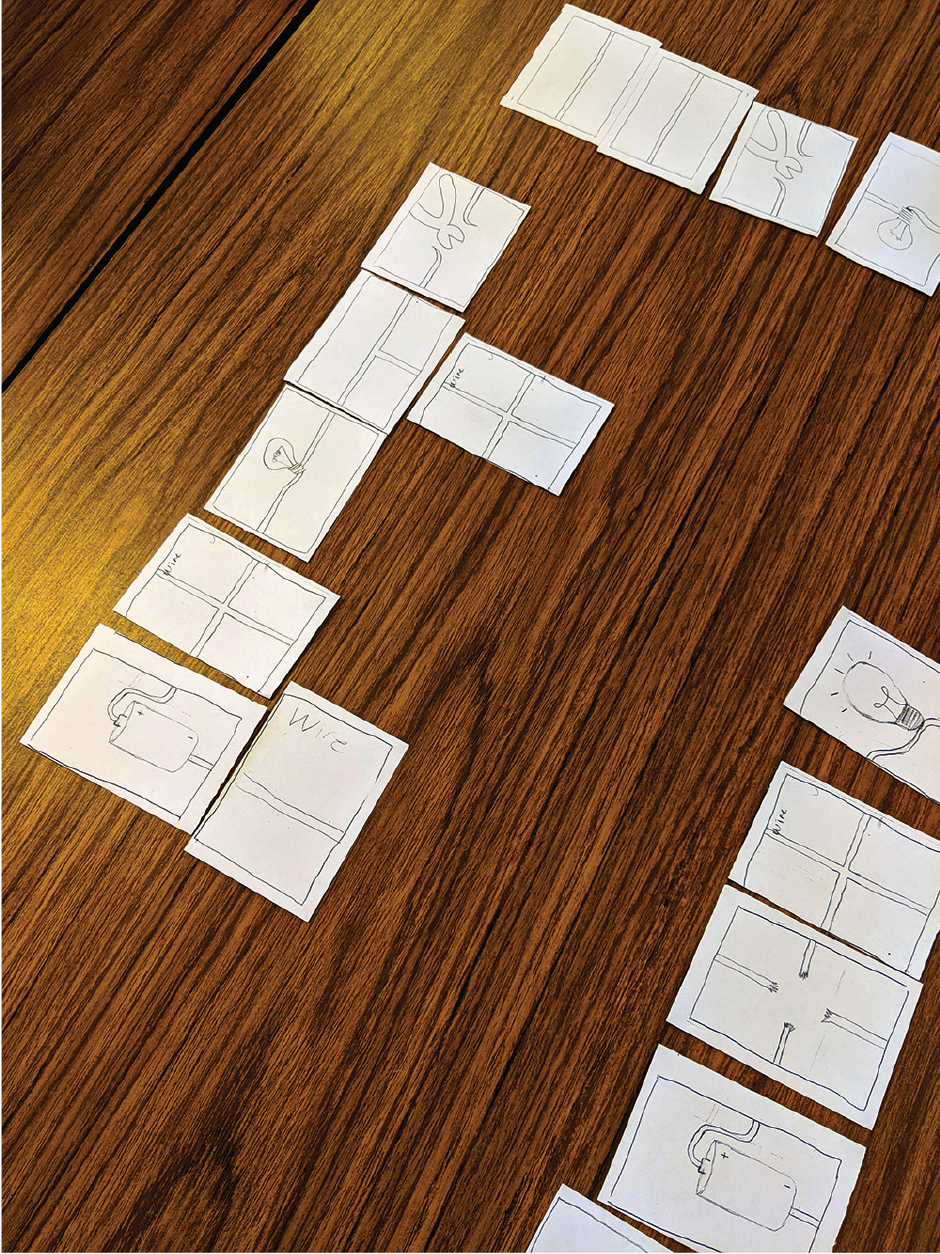
Community-building
A fourth category of games, with benefits for all types of students, are those involving community-building. Advanced Placement students need to relax and be kids once in a while; it’s nice if they can do it with you, the same person holding them to college-level expectations. English language learners need ways to socialize, using academic English in school but in a low-stakes environment. Students who struggle academically need to know you are human and want to have fun like everyone else.
Think Fast is a game I play using craft sticks with students’ names on them, based on the Brain Play page from Highlights magazine. I pick a student’s name and ask one of the questions from the page (for example, “Where is somewhere you are likely to hear a clicking sound?” or “What is the happiest sound?”). The only rules are that students may only answer the questions asked of them, and that they have to answer as quickly as possible. Answers aren’t allowed to be made fun of, and I don’t judge them. We learn a lot about each other this way and have a good time. It makes a nice change of pace not having to worry about a correct answer.
Games like this aren’t science related, which means they are also relatively short games that I don’t devote much time to. They are designed to serve as brain breaks to enjoy the last few minutes of class, on days we have finished our work three minutes before the bell rings. Two caveats about game-playing in the classroom: use sparingly and add variety. Just because it’s fun doesn’t mean it shouldn’t have a purpose.
Put yourself in your students’ shoes and keep in mind your teaching goals—even if one of them is to have fun for part of a class period. I don’t think that any classroom is in danger of playing too many games. After all, we have a lot to do and games, while valuable, aren’t usually time-efficient.
When you do plan a game, do it purposefully and sensitively. Not all students do things quickly. Not all students like to be creative. Not all students feel a need to win or to be the best. Using a wide range of types of games is most likely to engage the most students. Among those mentioned here, some games are active, some vocal/aural, some thinking, some experiencing. Some of these games have students creating and some make students follow directions. They are used as review, as a way to go deeper into a subject, or they may not be related to content at all. Playing games can be one tool of many in your toolbox, one spice in the rack to be applied on occasion, for flavor and depth. Bon appetít!
